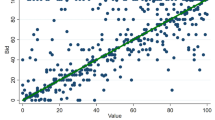Abstract
If valuations are interdependent and agents observe their own allocation payoffs, then two-stage revelation mechanisms expand the set of implementable decision functions. In a two-stage revelation mechanism agents report twice. In the first stage - before the allocation is decided - they report their private signals. In the second stage - after the allocation has been made, but before final transfers are decided - they report their payoffs from the allocation. Conditions are provided under which an uninformed seller can extract (or virtually extract) the full surplus from a sale to privately informed buyers, in spite of the buyers’ signals being independent random variables.
Similar content being viewed by others
References
Bennouri M., Falconieri S. (2006) Optimal auctions with asymmetrically informed bidders. Econ Theory 28, 585–602
Brusco S. (1998) Unique implementation of the full surplus extraction outcome in auctions with correlated types. J Econ Theory 80, 185–200
Crémer J., McLean R. (1985) Optimal selling strategies under uncertainty for a discriminating monopolist when demands are interdependent. Econometrica 53, 345–361
Crémer J., McLean R. (1988) Full extraction of surplus in Bayesian and dominant strategy auctions. Econometrica 56, 1247–1257
Gresik T. (1991) Ex ante incentive efficient trading mechanisms without the private valuation restriction. J Econ Theory 55, 41–63
Jehiel P., Moldovanu B. (2001) Efficient design with interdependent valuations. Econometrica 69, 1237–1259
Kosmopoulou G., Williams S.R. (1998) The robustness of the independent private value model in Bayesian mechanism design. Econ Theory 12, 393–421
McAfee P.R., Reny P. (1992) Correlated information and mechanism design. Econometrica 60, 395–421
McLean R., Postlewaite A. (2004) Informational size and efficient auctions. Rev Econ Stud 71, 809–827
Mezzetti, C. Auction design with interdependent valuations: the generalized revelation principle, efficiency, full surplus extraction and information acquisition. http://www.unc.edu/~mezzetti/ (2002)
Mezzetti C. (2004) Mechanism design with interdependent valuations: efficiency. Econometrica 72, 1617–1626
Myerson R.B. (1981) Optimal auction design. Math Oper Res 6, 58–73
Myerson R.B. (1986) Multistage games with communication. Econometrica 54, 323–358
Neeman Z. (2004) The relevance of private information in mechanism design. J Econ Theory 117, 55–77
Author information
Authors and Affiliations
Corresponding author
Additional information
This research was started when I was visiting the Department of Applied Mathematics of the University of Venice, and continued while visiting the European University Institute in Florence. Their financial support is gratefully acknowledged.
Rights and permissions
About this article
Cite this article
Mezzetti, C. Mechanism Design with Interdependent Valuations: Surplus Extraction. Economic Theory 31, 473–488 (2007). https://doi.org/10.1007/s00199-006-0104-8
Received:
Accepted:
Published:
Issue Date:
DOI: https://doi.org/10.1007/s00199-006-0104-8




